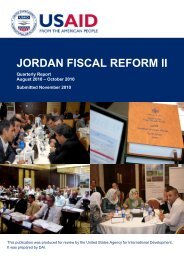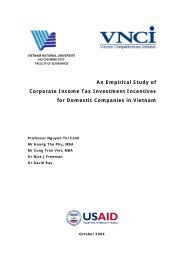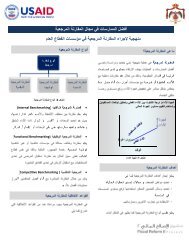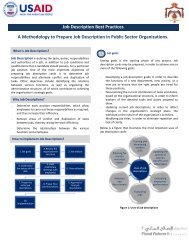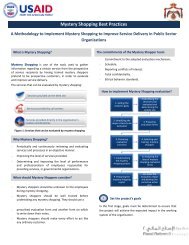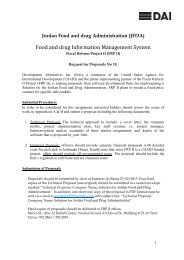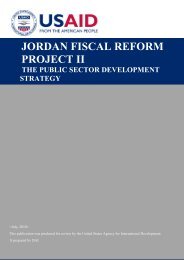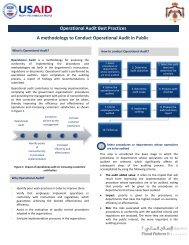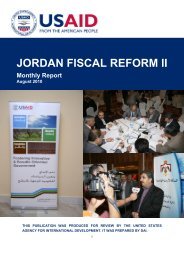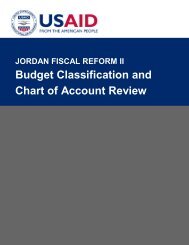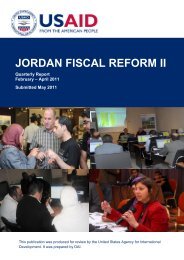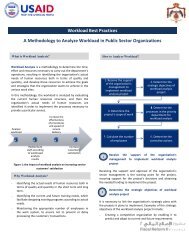Integrated Financial Management Information Systems: A ... - Frp2.org
Integrated Financial Management Information Systems: A ... - Frp2.org
Integrated Financial Management Information Systems: A ... - Frp2.org
You also want an ePaper? Increase the reach of your titles
YUMPU automatically turns print PDFs into web optimized ePapers that Google loves.
Like all good engineers, all quality hardware and software suppliers test their engineered products in<br />
their internal laboratories simulating situations of all types, ensuring that their products function. This<br />
is also why, as a rule, it is more cost effective to use COTS products for the process. There are very,<br />
very rare exceptions to this.<br />
Installing a government IFMIS is nothing more than a new production line, one that will handle<br />
information in a new way. All successful IFMIS installations have gone through a similar process.<br />
The systems introduced in Slovak Republic, Kosovo, and Slovenia, to name a few, were tested with<br />
data either on paper, or in actual hardware/software environments, to prove the system engineering<br />
design before advancing to the installation phase.<br />
Pre-testing the working model with real data—proving the functioning of the CoA, the software and<br />
integration processes, recording real transactions, and producing real reports—can mitigate future<br />
problems and speed up final installation. One option to consider is setting up a “laboratory”<br />
environment in which to test and calibrate the system. Unless one has unlimited resources to dispose<br />
of, a new system cannot simply be rolled out and switched on without this kind of testing. In the<br />
context of a Ministry of Finance alone, the impact of an IFMIS is enormous; the impact and the risks<br />
on a government-wide scale would be exponentially larger.<br />
To ensure that this step is built into the IFMIS project, it should be clearly laid out as one of the<br />
tender process milestones to prove that the solution will work before too many resources are<br />
committed to the project, thus avoiding wasted money, time and credibility. Of course, this does not<br />
obviate the need to pilot-test the system with real users in real budgetary units (e.g., within the<br />
finance ministry) before rolling the system out to the broader government.<br />
CONCLUDING REMARKS<br />
While this paper cannot cover all of the facets of IFMIS design, development and implementation, the<br />
thrust is to provide a basic understanding of what is required to bring an IFMIS successfully to life.<br />
Today, the systems themselves are based on tried and tested software and hardware platforms, which<br />
have worked thousands of times successfully. The problem when it comes to government<br />
environments is not an engineering problem, but one of inertia: inertia that is political and<br />
bureaucratic at its core. Introducing modern financial management systems demands a commitment to<br />
change: change in technology, in processes and procedures, as well as changes in skills,<br />
responsibilities and behaviors. Changes of this nature and magnitude have to be accepted from within<br />
and not simply imposed from the outside. Successes like the Slovak Republic were the result of real<br />
acceptance, at the highest levels of the political system. IFMIS success also requires donors to<br />
provide firmer monitoring, and firmer support to ensure sustainability. Too often these projects under<br />
perform or take much more time and effort than anticipated because costly mistakes were made,<br />
whether in the assessment and design stages, in the tender process, or in the course of system<br />
implementation.<br />
This paper proposes a series of best practice steps for introducing IFMIS based on experiences and<br />
knowledge of past successes and pitfalls. What is presented here is not a recipe for instant IFMIS<br />
success, for this is impossible. Instead, it highlights the key features that must not be overlooked, the<br />
key techniques that have been common in successful installations. Starting with these as a basis,<br />
IFMIS projects can be better designed and managed to produce the financial management and<br />
governance results that they are intended to have.<br />
30 INTEGRATED FINANCIAL MANAGEMENT INFORMATION SYSTEMS: A PRACTICAL GUIDE



